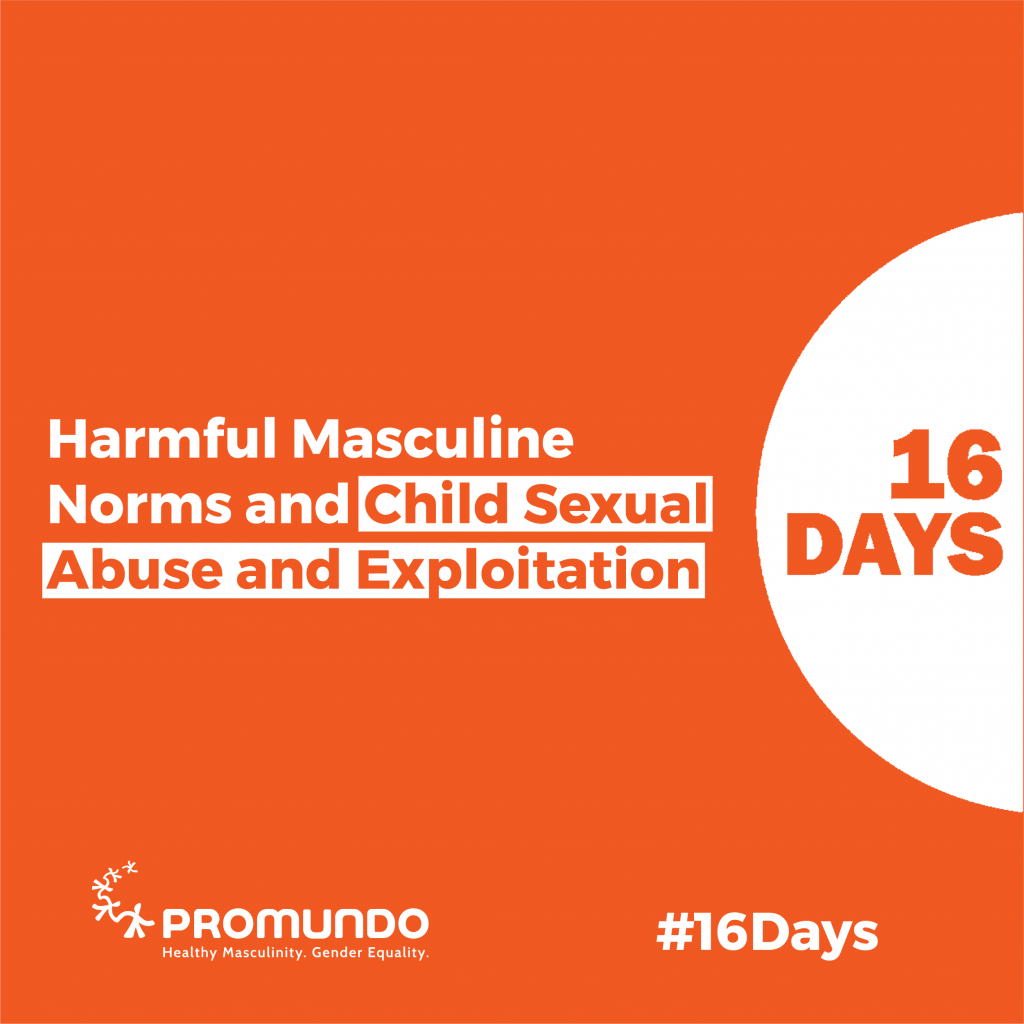Os 16 Dias de Ativismo Contra a Violência de Gênero são uma campanha internacional usada por ativistas ao redor do mundo (25 de novembro a 10 de dezembro) como uma estratégia de organização para pedir a eliminação de todas as formas de violência de gênero.
Este ano, compartilharemos pesquisas sobre as ligações entre normas masculinas prejudiciais e oito formas diferentes de comportamento violento, bem como insights e recomendações para eliminar todas as formas de violência.

Embora não haja nada inerente ao fato de ser homem que impulsione a violência, a maneira como socializamos os meninos em suas identidades como homens e o que esperamos deles — isto é, as normas masculinas da sociedade — estão inegavelmente ligados à violência.
De fato, meninos e homens são frequentemente criados, socializados e incentivados a usar a violência de alguma forma; em geral, homens e meninos têm uma probabilidade desproporcional de perpetrar a maioria das formas de violência e de morrer por homicídio e suicídio. No entanto, a pesquisa afirma que essa violência é prevenível, a igualdade de gênero é alcançável e normas e ideias não violentas sobre masculinidade são predominantes e poderosas.
Relatório da Equimundo e da Oak Foundation Normas Masculinas e Violência: Fazendo as Conexões, examina as ligações entre normas masculinas nocivas e oito formas de comportamento violento. Este terceiro blog no Fazendo as conexões, 16 Dias de Ativismo A série se concentra no abuso e exploração sexual infantil. Ela analisa os fatos sobre o abuso e a exploração sexual infantil, explora suas ligações com outras formas de violência e fornece recomendações para ações.
Abuso e exploração sexual infantil
Os fatos
O abuso sexual infantil e a exploração sexual infantil são fenômenos distintos com padrões distintos de prevalência em todo o mundo, com divergências entre acadêmicos sobre sobreposições e distinções nas causas subjacentes à perpetração.
Estimativas rigorosas de vários países sobre a incidência e prevalência de abuso sexual infantil são raras, mas todos os dados apontam para o enorme escopo dessa violência e para o fato de que os perpetradores são predominantemente homens.
A Organização Internacional do Trabalho estima que 1,8 milhões de crianças em todo o mundo são exploradas sexualmente todos os anos.
Os Links
Dada a preponderância de evidências de que a perpetração de abuso sexual infantil é um comportamento quase exclusivamente masculino, a pesquisa sobre normas de gênero e normas masculinas como causa raiz dessa violência é bastante limitada. Pesquisadores de abuso sexual infantil frequentemente discutem as condições sociais e os "ecossistemas sociais" que moldam, promovem ou restringem comportamentos sexualmente abusivos contra crianças. Grande parte da literatura sobre abuso sexual também aponta a "orientação antissocial" ou o "comportamento antissocial" como um importante preditor de agressão sexual e de reincidência entre infratores anteriores. No entanto, muitas características citadas como fatores que aumentam o risco de perpetração assemelham-se às normas masculinas prejudiciais discutidas neste relatório, como impulsividade, brigas e consumo excessivo de álcool.
Normas de gênero que associam a masculinidade à proeza heterossexual e ao acesso e controle sobre os corpos de mulheres, meninas, meninos e indivíduos de todas as identidades de gênero também contribuem para a perpetração masculina da exploração sexual. O tráfico de pessoas – e especificamente a exploração sexual de crianças (geralmente meninas na maioria dos contextos, mas predominantemente meninos em alguns contextos da Ásia Central) – também está relacionado às normas masculinas. No centro desses processos está a regulamentação rigorosa da vida sexual de mulheres e meninas e a simultânea hipersexualização de seus corpos desde a mais tenra idade.
As Interseções
Fatores sociais, como normas masculinas, interagem com fatores evolutivos, biológicos e situacionais na base da perpetração de abuso sexual infantil. Padrões e perpetração de abuso sexual infantil representam uma oportunidade importante para aplicar uma perspectiva de gênero – particularmente com foco em normas masculinas – em pesquisas futuras. Além disso, qualquer compreensão das causas profundas da exploração sexual infantil deve ir além do traficante ou consumidor individual de sexo, uma vez que a aceitabilidade social mais ampla do tráfico e da exploração sexual também desempenha um papel. Também é importante enfatizar que o abuso sexual infantil envolve, em grande parte, perpetradores que são parentes ou conhecidos da vítima.
Os efeitos geracionais das experiências de abuso sexual na infância também são claros: a incidência de agressão sexual na infância dos agressores costuma ser significativamente maior do que na população em geral.
Da Teoria à Prática
É raro que trabalhos focados na prevenção do abuso e da exploração sexual infantil incorporem abordagens que desafiem e visem mudar normas de gênero prejudiciais, abordando especificamente masculinidades prejudiciais. Iniciativas que visam prevenir o abuso e a exploração sexual infantil devem se concentrar nas seguintes transformações:
- Investigar e desconstruir as maneiras pelas quais as normas sociais relacionadas à masculinidade podem levar às mesmas tendências e práticas antissociais que estão ligadas à perpetração de abuso sexual infantil.
- Fornecer educação sobre o que é exploração sexual infantil e sobre como as dinâmicas de poder desiguais operam nas relações íntimas e sexuais entre um adulto e um menor.
- Demonstre os efeitos amplos, duradouros e nocivos da exploração sexual infantil para crianças de todos os gêneros e insista que ela nunca é justificada.
- Promover a discussão e a exploração de masculinidades e sexualidades alternativas que ofereçam ideias saudáveis e não violentas de masculinidade, desvinculadas de proezas sexuais, domínio e controle.
- Peça aos participantes que nomeiem, reconheçam e discutam a natureza exploradora do sexo transacional e como normas de gênero prejudiciais influenciam essa dinâmica.
